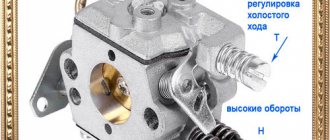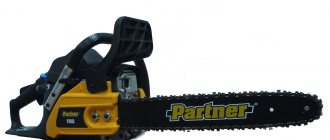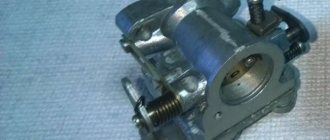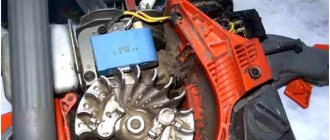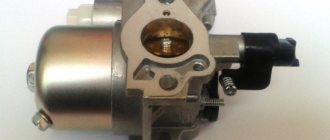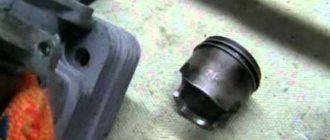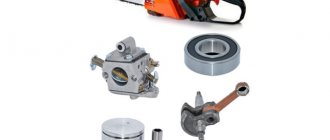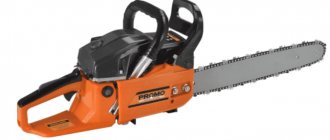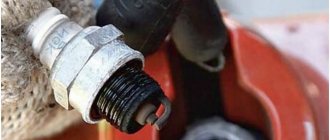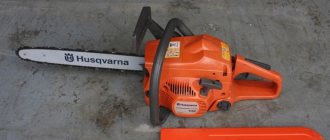Carburetor diagnostics
These compounds are good at cleaning the walls and parts of the carburetor from accumulated dust, carbon deposits and hardened resin.
After washing, the carburetor will need to be installed in its regular place in the chainsaw. Next, you will need to start the garden tool and observe its operation at idle and maximum speed. This procedure is necessary specifically in cases where a garden tool does not start or, after starting, immediately stalls. Adjusting the carburetor of a chainsaw is also necessary when its power has dropped or the amount of fuel consumed has noticeably increased. For self-adjustment, each manufacturer includes adjusting screws in the package of their garden equipment.
The bolt, marked H, is used to adjust the position of the main jet and the operation of the internal combustion engine at high speeds. Bolt L is necessary for basic adjustment of the position of the built-in idle speed jet generated by the motor. Accordingly, the T screw is required by the chainsaw owner to quickly adjust the idle speed of the factory engine.
In some cases, this bolt is also marked with the letters S or LA. Before setting up the carburetor on a chainsaw, you need to carefully prepare for the procedure.
Designed and originally created in Japan, the Makita DCS chainsaw has found widespread use throughout the world. Assembly at factories in Germany, England and Romania leaves no doubt about its quality. Accordingly, product sales in Europe, Asia and America confirm this. The Makita chainsaw belongs to the semi-professional class - it successfully copes with a wide range of work in the country, on a personal farm and on a farm. Tidying up the garden, pruning branches, cutting down trees, preparing firewood, filing elements during construction - the possibilities of the saw are truly endless.
First of all, you need to find descriptions of the angles of rotation of the adjusting screws in the instruction manual. If you arbitrarily turn the bolts without following the manufacturer's instructions, this can lead to serious damage to the engine of the tool. The motor itself must be in full working order. You should also thoroughly clean the air filter before tuning.
Otherwise, it will not be able to pass air in the volume required to enrich the fuel mixture, which will lead to incorrect carburetor settings.
Adjustment of the unit must be performed on a flat surface. The saw itself should be installed so that its saw attachment is located away from the operator's feet and face. Immediately before tuning, you will need to remove the upper part of the protective plastic body of the tool, as well as remove the foam rubber and part of the standard air filter.
To configure the unit, you will need a thin shaped screwdriver. You need to adjust the carburetor of a chainsaw in 2 stages. The first one is basic. While performing it with the chainsaw turned off and the engine cold, you need to alternately screw in the bolts H and L in the clockwise direction until it stops.
After this, each of the screws will need to be unscrewed 1.5 turns in the opposite direction.
At the end, the chainsaw you are using will need to be turned off and started again. It should operate stably at idle speed, and its chain in this mode should not rotate along the bus.
When you press the gas trigger, the saw should quickly gain speed, and when it is released, it should release it. The first reason for this failure is that the fuel filter is clogged with dust and dirt.
This happens due to the presence of a large amount of harmful impurities in gasoline and the used motor oil. Over time, they accumulate on the surface of the filter, causing it to lose its ability to pass fuel. To solve the problem, you will need to thoroughly clean the filter by rinsing it in a bath of cleaning agent. If the filter develops holes or other signs of wear, it needs to be replaced immediately.
The second cause of failure is contamination or breakage of the tube through which fuel is supplied to the carburetor. If the hose is not torn, then cleaning it will be enough to thoroughly blow it with compressed air from an aerosol.
If the tube is broken, it will need to be replaced. When installing the hose, the joints between it and the fittings must be carefully treated with sealant.
There is one more malfunction that occurs much less frequently than the previous two. It consists of a breakdown of the valve that regulates the rate of fuel supply to the carburetor.
Comments
If dust or small chips get inside its mechanism, the damper is blocked and remains in the closed position. Repair of the unit can only be done by replacing the damper, since it most often cannot be restored. Often, chainsaw carburetor malfunctions are associated with loud extraneous sounds that come from the unit.
Ignoring them will lead to even more serious damage, which will be much more difficult to eliminate. First of all, you need to understand the causes of extraneous sounds. The first of them is an incorrectly set ignition, due to which the used fuel does not have time to burn in the internal combustion engine cylinder in time.
This leads to the formation of a short-term shooting noise that is repeated with each cycle of fuel injection into the cylinder. To fix the problem, you need to adjust the gap between the flywheel and the standard ignition coil of the chainsaw.
Question: I have a Makita chainsaw, and soon it started stalling from time to time, in other words, it starts normally, but you release the gas and it stalls. It stalls due to the fact that the starting valve, which must be pressed before starting, does not come back out after it starts, it seems to be stuck there.
To do this, you need to remove the left protective cover of the plastic case and clean the parts underneath. To the right of the ignition coil there are 2 screws, turning them counterclockwise will allow you to move the flywheel away from the standard coil.
Next, you will need to attach a template to the side of the coil and begin to slowly turn the factory screws in the opposite direction.
As soon as the built-in flywheel comes close to the previously installed template, you will need to stop turning the screws. After adjusting the ignition gap, you need to check the operation of the chainsaw. If it still fires, then you need to inspect the spark plug.
If carbon deposits have accumulated on it, the part must be cleaned and completely dried. Another reason why the chainsaw you are using is firing is due to the incorrect proportion of the prepared fuel mixture. If there is too little gasoline or motor oil, the engine of the garden tool will not be able to operate stably.
In this case, you will need to completely drain the fuel and prepare the mixture in accordance with the manufacturer's instructions. In some cases, a disturbance in the supply of fuel to the engine cylinder may be caused by improper operation of the standard carburetor jets. In this case, you will need to adjust the carburetor and alternately check the operation of the tool at idle, low and high speeds.
To prevent the breakdown of a standard unit, the owner of a garden tool should adhere to a number of rules. These include:. During operation of the chainsaw, you need to ensure that dust, sawdust and small debris do not seep under its body. Otherwise, they will quickly clog the carburetor and block its operation. Any chainsaw is equipped with a two-stroke single-cylinder carburetor engine.
Early models of chainsaws were equipped with contact ignition, but now almost all manufacturers use electronic ignition, so there is no need to constantly clean the contacts and adjust the gap between them. The air-fuel mixture to operate the engine is mixed in the carburetor. Using a special damper, you can manually lean or enrich the fuel mixture for a specific purpose - for example, for cutting hard wood.
Both the health of the engine and the performance of the chainsaw directly depend on the good technical condition of the carburetor. Let's take a closer look at how a chainsaw carburetor works. Almost all chainsaw models use an identical carburetor design.
When is carburetor adjustment required?
As an exception, we can name the carburetor of some very cheap Chinese chainsaw - some parts may be missing, and most of the components are made of very cheap materials. Before you adjust the carburetor on a chainsaw, you need to understand the principle by which it works. It should be understood that the dimensions of all holes are very small. Even the smallest contamination can block the flow of air or fuel, which is why filter elements are installed at the inlet ports.
Unfortunately, they do not always cope with the task.
The following signs indicate a malfunction of the chainsaw carburetor:. All these malfunctions are a sign that the carburetor on the chainsaw is not adjusted correctly or that it is dirty.
This implies the need for adjustment, cleaning or repair. We'll look at how to do this below.
Purpose
The Makita 4610 chainsaw belongs to the semi-professional class - it successfully copes with a wide range of work in the country, on a personal farm and on a farm. Tidying up the garden, pruning branches, cutting down trees, preparing firewood, filing elements during construction - the possibilities of the saw are truly endless.
Makita 4610 at work
In addition, using special attachments, the functions of the saw change. It easily turns into a winch, ice drill, wood router and a number of other useful tools.
The use of unlicensed attachments is not recommended.
Purpose and use of the Makita dcs34 chainsaw
According to the manufacturer's recommendations, the Makita DCS34 chainsaw should be used to solve simple problems that occur in everyday life. It is ideal for cutting posts when constructing a fence. It can be useful for cutting tree branches or preparing firewood for lighting a bathhouse or lighting a barbecue.
If the Japanese knew where their chainsaw was actually used, they would be shocked. Makita 34 can be found at the sawmill, where it is used by everyone who gets its hands on it. It is interesting that the quality of fuel and lubricants, as well as the proportions of the fuel mixture, in such conditions are not observed or are observed approximately. But Makita, even in such “barbaric” conditions, is able to work for quite a long time.
Since the service life of the Makita DCS 34-35 is not designed for such conditions, after some time it will definitely end up in repair. But this does not stop anyone, because the cost of a household model and a professional one has a significant difference, and if you do your own repairs, it turns out to be more profitable to use a household model.
We invite you to watch a video about the Makita chainsaw, in which the seller talks about the advantages of this DCS 34-35 model.
Specifications
The saw is characterized by its small size and weight with a fairly powerful engine. This makes its use convenient and reliable in any area where sawing wood is required. The most complete characteristics are given in the table.
Characteristics of the Makita 4610 chainsaw
The engine is two-stroke. It runs on a fuel mixture of gasoline and oil. Has easy starting at positive and negative temperatures. The electronic ignition system contributes to this.
The anti-vibration system together with ergonomic handles make handling the Makita DCS 4610 chainsaw less tiring.
Inertial chain brake mounted on the saw operates in manual and automatic modes, which reliably ensures personal safety when handling a running chainsaw.
The chain catcher stops the movement of the chain when it breaks. This prevents damage to the saw and injury to the operator.
Tire and chain. Refers to consumables. When replacing, these parts must be installed in accordance with the recommendations in the instructions for using the Makita DCS 4610 chainsaw. Particular attention is paid to maintaining the dimensions.
Automatic chain lubrication system. Oil is supplied to the bar only while the saw chain is rotating, which reduces overall oil consumption.
A more detailed review of the Makita 4610 chainsaw is presented in the video
How to properly adjust the carburetor with your own hands?
After washing and completely cleaning the carburetor, it is assembled and adjustments begin. First of all, you should understand the purpose of the adjusting screws. The instructions will help with this, but some general points should be considered immediately. The most common designation for screws is:
- H - adjusts the state of the main jet, i.e. adjusts the maximum rotation speed of the motor shaft;
- L — adjusts the idle jets (responsible for the minimum shaft rotation speed);
- T - regulates engine idle speed. It can also be designated by the letters LA or S; on some carburetor models it is completely absent.
READ Chainsaw Husqvarna 372 Xp 18 Fuel Consumption
Turning screws H and L clockwise leans the fuel-air mixture, and counterclockwise turns it rich (the amount of gasoline increases). When screw T rotates, the shaft rotation speed at idle speed changes - clockwise it increases, and in the opposite direction it decreases.
Figure 2 – Carburetor adjustment mechanisms
Before you begin direct action, you should find and carefully study information about the position of the adjusting screws (the magnitude of the rotation angles when adjusting). This information is available in the instructions for the chainsaw. Then you need to prepare the workplace - lay the saw on a flat horizontal plane, pointing the chain in the direction opposite to you. Disconnect all covers, remove foam and air filter. At this point, the preparatory operations are considered completed, and the main part of the work can begin.
- Smoothly tighten screws H and L clockwise until they stop. Be careful not to break the screws - this will cause complete loss of the carburetor.
- Unscrew both screws one and a half turns.
- Run the engine for 10 minutes and warm it up. This is a necessary point, since it will not be possible to adjust the carburetor correctly on a cold engine.
- By turning screws H and L, alternately adjust the rotation of the shaft at maximum and minimum speed.
- By adjusting the position of screw T (or it may have a different designation), the idle speed of the chainsaw is adjusted. It is necessary to achieve smooth and stable engine operation. It is important to monitor whether the chain moves at idle or not. If it moves, turn the screw counterclockwise a little more.
Important! It is better not for an inexperienced person to adjust screw H. If it is not configured correctly, a lean air-fuel mixture will be supplied to the cylinder combustion chamber at maximum speed. This will lead to accelerated wear of the piston group.
You can check the engine's operation visually and by ear. A mixture that is too rich causes thick smoke to come out of the exhaust. When feeding a lean mixture, a whistle is heard while the saw is running. Excessively economical mode is harmful - if screw L is set to “lean” fuel, problems will arise with starting the engine. When setting screw H to a lean mixture, the saw will noticeably lose power. The correct setting can be determined by the following criteria:
- at idle, the engine does not stall, and the chain does not move;
- there is no excessive smoke from the exhaust pipe when the engine is running;
- the engine demonstrates good throttle response (quickly picks up speed when you press the accelerator).
A detailed description of the settings is available in the instructions that come with the tool in the package. It should be carefully studied, since there may be some features or specific requirements established by the manufacturer and relating only to this model of saw. If all requirements are met exactly, the operation of the chainsaw will be restored to its original state.
Equipment
The manufacturer supplies the product in the following configuration:
- saw;
- tire;
- saw chain;
- protective case;
- universal key;
- user manual.
The required minimum components are listed.
Additionally, for comfortable and safe work, you must separately purchase PPE (personal protective equipment):
- protective helmet;
- glasses;
- headphones;
- jacket and trousers;
- mittens;
- shoes.
In addition, if you need to expand the capabilities of the saw, you can additionally buy a number of special attachments, which were mentioned earlier.
Advantages and disadvantages
Like any mechanism, the Makita 4610 chainsaw has certain advantages and disadvantages. The positive aspects include:
- safety at work;
- high engine power;
- economical fuel and oil consumption;
- ease of maintenance;
- light weight;
- possibility of using nozzles.
No real shortcomings were found, although some users publish negative reviews about the saw. Most likely, the occurrence of malfunctions is caused by inability to handle a chainsaw or a direct violation of the requirements of the “Operating Instructions”. This is directly indicated by the following review:
Review from user Nikolay
If you fill in the recommended oil and monitor its level, the oil pump will never fail. And the “plastic gear on the drive” is installed on all brands of saws. So the problem here is definitely not in the pump, and therefore not in the chainsaw. According to many users, the only weak point in the Makita DCS4610 is the carburetor. A little later, the problem associated with it will be discussed in more detail.
Chainsaw for household Makita DCS4610
The factory settings of the chainsaw carburetor provide optimal fuel and air suction parameters. Regardless of the manufacturer, the principle and operating procedure of the carburetor of internal combustion engines is similar. For mixing air and fuel, the carburetor is a device that includes:. Air under atmospheric pressure, having passed the air cleaner, is supplied to the narrowing zone, where its flow is regulated by a flat damper blocking the cross-section.
After the narrowing, a vacuum appears in the pipe. As a result, the vacuum sucks fuel from the fuel supply tube, the outlet of which is regulated by a fuel needle connected to the float chamber by a nozzle. The design of a chainsaw carburetor is, in principle, no different from other fuel mixers in internal combustion engines. The principle of mixing is to regulate the air damper and float level, depending on the degree of vacuum. We open the air - more fuel comes in, the engine increases speed.
The correct ratio of combustible consistency depends on the precise adjustment of the chainsaw carburetor. If there is a lot of air in the fuel, the power drops and the mixture is called lean. If there is not enough air, there is a high fuel consumption, incomplete combustion, carbon deposits on the cylinder and the release of unburned fuel.
How to dilute oil and gasoline
The Makita 4610 chainsaw engine runs on a mixture of gasoline and oil. In order to prepare it correctly, take 50 parts of high-octane gasoline (for example, AI-92) and 1 part of special MAKITA oil for two-stroke engines. These components are mixed together in a clean container. To do this, you can use a canister or any similar container.
Original Makita fuel and lubricants
First, the oil is poured into half of the required fuel, everything is mixed well, then the remaining fuel is added and everything is mixed well again. As an example, the following proportion is given: 1 liter of gasoline requires 20 cm³ of oil.
In a desperate situation, when it is not possible to purchase MAKITA oil, it can be replaced with any other for two-stroke engines. In this case, the mixture is prepared in a ratio of 40:1. In digital terms, it looks like this: 1 liter of gasoline requires 25 cm³ of oil.
To accurately measure the oil, you can use disposable medical syringes.
Tools
A chainsaw is an irreplaceable tool, both in the homestead and in the summer cottage. But even the most reliable “iron” assistant begins to mope, sometimes it won’t start, sometimes it stalls. There can be a huge number of circumstances, both related to the quality of the fuel consistency and to the engine.
There are a lot of aspects, we will not consider all of them in this article. Let’s take a closer look at that part of the engine called the carburetor. And we will try to find the answer to the following questions: when is it necessary to adjust the carburetor of a chainsaw and, in fact, what is the scheme for such adjustment.
In what cases is adjustment necessary?
In general, the need to adjust the carburetor of a STIHL chainsaw, or any other brand, appears quite occasionally. Signs of a misadjusted carburetor are indicated by:
- the engine starts and stalls, or does not start - in this case, the prerequisite may be a “poor” fuel mixture;
- Fuel consumption has increased significantly and the amount of exhaust gases has increased (one hundred percent of the fuel does not burn). a prerequisite may be a supersaturated mixture.
The adjustment itself goes wrong in very rare cases, namely:
- when the fixation of the adjusting screws was broken, there are three in total. The reason may be vibration or damage to the protective cap. This is a fairly rare case if no one touched the screws.
- in case of significant wear of the engine, specifically the piston. Then the factory options are not suitable. In this case , adjusting the carburetor of a Patriot chainsaw or another model can save the situation for some time. But here it’s time to think more about engine repair than adjusting the carburetor of a Husqvarna chainsaw or something similar;
- the reason may be due to the formation of a blockage in the carburetor; the reason may be poor quality gasoline, damage to the air filter, or scale. In this option, in addition to adjustment, you need to disassemble and flush the carburetor.
Adjusting the chainsaw carburetor
Although quite occasionally, carburetor adjustment may still be required. Let us immediately note that not everything can be done without the help of others, unless you have a tachometer and at least once see with your own eyes how to do it correctly.
To adjust the carburetor of the Makita chainsaw, like most other models, there are three adjusting screws. Although some manufacturers carefully removed two of them, leaving only one for user experimentation. So, three screws, on the carburetor body they are indicated by the following signs:
- L – this screw is used to adjust low engine speeds;
- H – high speed adjustment
- T – for adjusting idle speed (this is left for testing).
In general, the carburetors are already adjusted by the manufacturer for rational operation, and the screws are designed for more precise adjustment of the carburetor of Champion chainsaws and others, in difficult weather conditions, such as high mountains, etc. Since the air there is thinner, the instrument requires a more precise setting to operate. In ordinary conditions this is not necessary.
To adjust the carburetor of a Goodluck chainsaw, as well as other brands, two screws L and H are used to create the appropriate fuel consistency. To create a lean consistency, the screws are turned clockwise, this allows you to increase the number of revolutions, i.e. Thus, they set the highest speed. Accordingly, when turning the screws counterclockwise, the mixture becomes more saturated, this regulates the low number of engine revolutions. Thus, when adjusting the carburetor of the Partner chainsaw, by turning the screws clockwise we increase the number of revolutions, and counterclockwise we decrease it.
Whenever adjusting the carburetor of a Chinese chainsaw or another, you must comply with a number of requirements:
- precise adjustment is always carried out when the engine is warm (running the engine for at least 10 minutes);
- The condition of the air filter must be satisfactory, i.e. unsullied and unclogged;
- When rotating the chain using the adjusting screw T, you need to achieve its complete stop; to do this, the screw is turned counterclockwise.
READ Chainsaw Oil Adjustment
And don’t forget about your safety, the chain should be oriented in the opposite direction to us, the saw should stand firmly on a level surface and not touch any objects with the cutting part. With precise adjustment, the screws are adjusted in the following sequence L. H – T. Using screw L, you need to “find” the maximum number of engine revolutions. To do this, turn the screw clockwise, or in the opposite direction, until we “feel” for the maximum. This is where you need a tachometer, or a discerning ear for music, and you should know the sound of the maximum engine speed; if you overdo it, especially with the H regulator, the engine will fail. Repairs will cost a pretty penny, which is why we strongly advise entrusting such work to a specialist.
If you have a tachometer and understand the maximum number of revolutions of your engine, then you can, at your own horror and risk, try to complete the adjustment. It will look approximately as follows: we find a very close speed value with the L regulator, then use the same regulators to return it counterclockwise by a quarter of a turn of the screw. We leave it and go to regulator H, and if you tighten it too much, the engine will fail.
We turn this regulator ¼ turn of the screw counterclockwise (we warm up the engine before doing this). We listen closely or use the tachometer as a guide. If the sound is our standard, when the engine operates at maximum it works like a four-stroke engine. With a very rich consistency, the sound is squealing. You can try to achieve an average value, not have a standard, but use a screw to remove the squealing sound. And if the work of the saw suits you, it’s better to quit, because there is, it’s better than being left without a motor.
If you managed to more or less adjust the screws L and H, then there is only a little left to adjust the idle speed. The standard here is to ensure uniform operation of the motor in all positions until the chain begins to move. Rotate this screw counterclockwise until the chain stops. If this cannot be achieved, you need the help of a specialist. An unregulated chainsaw is a very scary thing.
An excellent and correctly adjusted carburetor is:
- the chain is “standing” at idle;
- the engine accelerates rapidly;
- The engine operates like a four-stroke engine.
Below is a video of adjusting the carburetor of a chainsaw
Acceleration check
If you press the gas button of the chainsaw, the engine should increase the number of revolutions. This should happen quite quickly. If the tool picks up speed slowly, you need to unscrew the screw L a little, no more than 1/8 of a turn.
When the setup is completed, you need to re-check the operation of the chainsaw at idle speed - the engine should work properly, and the chain should remain motionless. If the engine is unstable or the chain moves, it is necessary to repeat the adjustment, lowering the step of the basic option.
Modifications DCS 4610-35 and DCS 4610-40
The most popular brands in the line of chainsaws have proven themselves to be Makita DCS 4610-35 and Makita DCS 4610-40. Both models cope excellently with all work in personal and farming. The Makita DCS 4610-35 is most suitable for the dacha, since it is equipped with a 35 cm long bar. Small in size, with a powerful engine, the saw is very convenient when performing various jobs on a construction site.
Makita DCS 4610-40 has a tire size of 40 cm. This configuration expands the possibilities of using the model. You can safely take the saw into the forest to fell trees, but only to satisfy your personal needs. It is not intended for professionals.
Details about the design of the Makita DCS4610 chainsaw can be seen in the video
Thus, the modifications of these chainsaws differ only in the length of the saw bar.
Step-by-step disassembly instructions
The design of the carburetor for models of different brands is virtually the same, so let’s take the Partner chainsaw as an example. We carefully remove each element and place it in order to make it easier to assemble later.
Carburetors of chainsaws from different manufacturers, if they differ, are not fundamentally different
The top cover is removed by unscrewing 3 bolts. Directly behind it is foam rubber, an integral part of the air filter.
The arrows indicate the bolts that need to be unscrewed to remove the cover.
Then we remove the fuel hose, followed by the drive rod.
The top arrow points to the fuel hose, the bottom arrow to the drive rod
Next you should remove the cable end.
The arrow shows the cable tip that needs to be removed.
We pull off the gasoline hose from the fitting on the left.
We also carefully remove the gasoline hose, which the arrow points to.
We completely disconnect the carburetor, it is ready for adjustment. Its mechanism is quite complex, therefore, if the upcoming disassembly of the carburetor is required, you should remove the elements very carefully - they are small, so they can get lost.
The carburetor consists of a huge number of small parts, which should be laid out in order when disassembling
Chainsaw carburetor maintenance
Instructions
The operating instructions for the chainsaw contain all the necessary requirements, fulfilling which ensures safe operation, proper maintenance and repair of the Makita chainsaw. Following its recommendations will extend the life of the saw.
Fragment from the “Operating Instructions” Makita DCS 4610
The instructions describe in detail and illustrate only those maintenance and repair work that you can do yourself.
Advantages and disadvantages of the Makita carburetor
Makita chainsaws are very reliable tools compared to Chinese ones. The service life of a new saw is very long and the need to adjust or repair the carburetor appears only after a long period of operation, when natural wear occurs in the parts.
Chinese carburetor . Nowadays everything is created in China, their quality is lower compared to Japanese ones, but still it is at a fairly high level, thanks to control over the properties of the products produced.
Launch
According to the requirements of the Operating Instructions, the saw must be fully prepared and checked before starting. The preparation includes operations for assembling the chainsaw after purchasing it. This includes mounting the bar and saw chain, refueling with fuel and oil.
After completing this work, the functioning of all components and parts of the chainsaw is checked. Particular attention is paid to the absence of fuel and oil leakage, the reliability of all fastenings, and the integrity of parts. Then the engine starts. The instructions describe in detail how this is done.
How does a carburetor work?
All processes occurring in the engine do not have a cyclical, but a constant base.
How to set the maximum speed of a chainsaw?
To change the highest speed, it is necessary to interact with screw H. If you tighten the screw, the speed will become higher, and if you unscrew it, it will become lower. Typically, the highest permissible engine speed ranges from 11,500 to 15,000 per minute. If you try to work with an even larger number, problems with the ignition will begin. In this case, unscrew the screw a little.
Basic carburetor adjustment
Screws H and L must be turned clockwise until they stop, and then unscrewed 2 turns in the opposite direction. This is the standard procedure for the initial setup of favorite chainsaw models. Other options are also possible.
Adjusting the carburetor of the Makita DCS 4610 chainsaw
Unlike other saws, the carburetor is adjusted only with the idle screw (S). Other adjusting screws must not be used.
From the Makita instructions on carburetor adjustment
To the question of how to adjust the Makita DCS4610 carburetor, the “Operating Instructions” gives a detailed answer:
Fragment. Carburetor adjustment
Thus, it is not difficult to conclude that the carburetor is not a weak point in the saw.
Those who use gasoline with a high octane number, for example, AI-95 or AI-98, do not have problems with the carburetor.
To adjust the carburetor on a Makita chainsaw, read this article, it contains detailed instructions applicable to any gasoline-type saw.
Carburetor repair for Makita chainsaw
Signs that the adjustment is no longer enough and the Makita chainsaw carburetor needs to be repaired:
- Arbitrary changes (abrupt) engine power;
- Excessive fuel consumption;
- Increased vibration and popping;
- “Sneezing” and unstable engine operation;
And of course, the obvious symptom is that the engine won't start or stop.
To repair the carburetor, it will need to be removed; it is located directly under the top cover of the chainsaw and the air filter.
Location of the carburetor on a Makita chainsaw.
Basic malfunctions and their elimination
Random power changes may be caused by damaged mounting screws. Removed by replacing them.
Damage also affects the control diaphragm or the diaphragm in the fuel pump. The fuel needle supply valve, its jamming during a long break in operation, or simply wear and tear may be clogged.
Problems may arise due to loss of tightness of the fuel pump gasket. All these carburetor malfunctions can be eliminated by purchasing a repair kit and replacing damaged parts.
Fix yourself or trust a pro
The question is quite sensitive. You can decide to repair the carburetor of a Makita chainsaw only if you are completely confident in your abilities. Some knowledge of mechanics and how a carburetor works is required.
The carburetor is a rather complex part of the engine, it has small parts and requires great precision and dexterity to replace them. When it comes to faults, almost everything can be fixed on your own as they converge to find the damaged element and replace it. Parts cannot be restored; nothing needs to be fixed with a hammer.
Carburetor repair kit
Makita chainsaw carburetor repair kit:
- Diaphragms (control and fuel pump);
- Gaskets;
- Needle valve (needle, spring, lever).
This is graphically represented in the figure, the parts of the repair kit are marked with a contour line.
